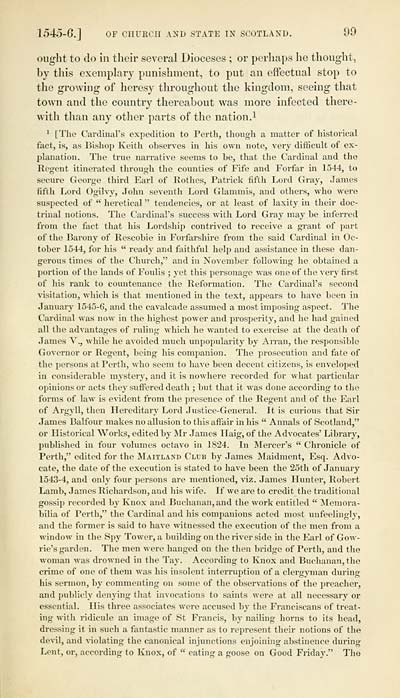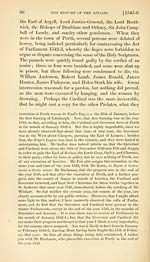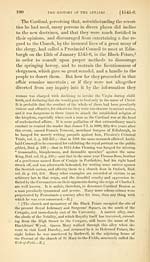Spottiswoode Society > History of the affairs of the Church and State of Scotland from the beginning of the reformation to the year 1568 > Volume 1
(235) Page 99
Download files
Complete book:
Individual page:
Thumbnail gallery: Grid view | List view

1545-6.] of church and state in Scotland. 00
ought to do in their several Dioceses ; or perhaps he thought,
by this exemplary punishment, to put an effectual stop to
the growing of heresy throughout the kingdom, seeing that
town and the country thei*eabout was more infected there-
with than any other parts of the nation. 1
1 [The Cardinal's expedition to Perth, though a matter of historical
fact, is, as Bishop Keith observes in his own note, very difficult of ex-
planation. The true narrative seems to be, that the Cardinal and the
Regent itinerated through the counties of Fife and Forfar hi 1544, to
secure George third Earl of Rothes, Patrick fifth Lord Gray, James
fifth Lord Ogilvy, John seventh Lord Glammis, and others, who were
suspected of " heretical " tendencies, or at least of laxity in their doc-
trinal notions. The Cardinal's success with Lord Gray may be inferred
from the fact that his Lordship contrived to receive a grant of part
of the Barony of Rescobie in Forfarshire from the said Cardinal in Oc-
tober 1544, for his " ready and faithful help and assistance in these dan-
gerous times of the Church," and in November following he obtained a
portion of the lands of Foulis ; yet this personage was one of the very first
of his rank to countenance the Reformation. The Cardinal's second
visitation, which is that mentioned in the text, appears to have been in
January 1545-6, and the cavalcade assumed a most imposing aspect. The
Cardinal was now in the highest power and prosperity, and he had gained
all the advantages of ruling which he wanted to exercise at the death of
James V., while he avoided much unpopularity by Arran, the responsible
Governor or Regent, being his companion. The prosecution and fate of
the persons at Perth, who seem to have been decent citizens, is enveloped
in considerable mystery, and it is nowhere recorded for what particular
opinions or acts they suffered death ; but that it was done according to the
forms of law is evident from the presence of the Regent and of the Earl
of Argyll, then Hereditary Lord Justice-General. It is curious that Sir
James Balfour makes no allusion to this affair in his " Annals of Scotland,"
or Historical Works, edited by Mr James Haig, of the Advocates' Library,
published in four volumes octavo in 1824. In Mercer's " Chronicle of
Perth," edited for the Maitland Club by James Maidment, Esq. Advo-
cate, the date of the execution is stated to have been the 25th of January
1543-4, and only four persons are mentioned, viz. James Hunter, Robert
Lamb, James Richardson, and his wife. If we are to credit the traditional
gossip recorded by Knox and Buchanan, and the work entitled " Memora-
bilia of Perth," the Cardinal and his companions acted most unfeelingly,
and the former is said to have witnessed the execution of the men from a
window in the Spy Tower, a building on the river side in the Earl of Gow-
rie's garden. The men were hanged on the then bridge of Perth, and the
woman was drowned in the Tay. According to Knox and Buchanan, the
crime of one of them was his insolent interruption of a clergyman during
his sermon, by commenting on some of the observations of the preacher,
and publicly denying that invocations to saints were at all necessary or
essential. His three associates were accused by the Franciscans of treat-
ing with ridicule an image of St Francis, by nailing horns to its head,
dressing it in such a fantastic manner as to represent their notions of the
devil, and violating the canonical injunctions enjoining abstinence during
Lent, or, according to Knox, of " eating a goose on Good Friday." The
ought to do in their several Dioceses ; or perhaps he thought,
by this exemplary punishment, to put an effectual stop to
the growing of heresy throughout the kingdom, seeing that
town and the country thei*eabout was more infected there-
with than any other parts of the nation. 1
1 [The Cardinal's expedition to Perth, though a matter of historical
fact, is, as Bishop Keith observes in his own note, very difficult of ex-
planation. The true narrative seems to be, that the Cardinal and the
Regent itinerated through the counties of Fife and Forfar hi 1544, to
secure George third Earl of Rothes, Patrick fifth Lord Gray, James
fifth Lord Ogilvy, John seventh Lord Glammis, and others, who were
suspected of " heretical " tendencies, or at least of laxity in their doc-
trinal notions. The Cardinal's success with Lord Gray may be inferred
from the fact that his Lordship contrived to receive a grant of part
of the Barony of Rescobie in Forfarshire from the said Cardinal in Oc-
tober 1544, for his " ready and faithful help and assistance in these dan-
gerous times of the Church," and in November following he obtained a
portion of the lands of Foulis ; yet this personage was one of the very first
of his rank to countenance the Reformation. The Cardinal's second
visitation, which is that mentioned in the text, appears to have been in
January 1545-6, and the cavalcade assumed a most imposing aspect. The
Cardinal was now in the highest power and prosperity, and he had gained
all the advantages of ruling which he wanted to exercise at the death of
James V., while he avoided much unpopularity by Arran, the responsible
Governor or Regent, being his companion. The prosecution and fate of
the persons at Perth, who seem to have been decent citizens, is enveloped
in considerable mystery, and it is nowhere recorded for what particular
opinions or acts they suffered death ; but that it was done according to the
forms of law is evident from the presence of the Regent and of the Earl
of Argyll, then Hereditary Lord Justice-General. It is curious that Sir
James Balfour makes no allusion to this affair in his " Annals of Scotland,"
or Historical Works, edited by Mr James Haig, of the Advocates' Library,
published in four volumes octavo in 1824. In Mercer's " Chronicle of
Perth," edited for the Maitland Club by James Maidment, Esq. Advo-
cate, the date of the execution is stated to have been the 25th of January
1543-4, and only four persons are mentioned, viz. James Hunter, Robert
Lamb, James Richardson, and his wife. If we are to credit the traditional
gossip recorded by Knox and Buchanan, and the work entitled " Memora-
bilia of Perth," the Cardinal and his companions acted most unfeelingly,
and the former is said to have witnessed the execution of the men from a
window in the Spy Tower, a building on the river side in the Earl of Gow-
rie's garden. The men were hanged on the then bridge of Perth, and the
woman was drowned in the Tay. According to Knox and Buchanan, the
crime of one of them was his insolent interruption of a clergyman during
his sermon, by commenting on some of the observations of the preacher,
and publicly denying that invocations to saints were at all necessary or
essential. His three associates were accused by the Franciscans of treat-
ing with ridicule an image of St Francis, by nailing horns to its head,
dressing it in such a fantastic manner as to represent their notions of the
devil, and violating the canonical injunctions enjoining abstinence during
Lent, or, according to Knox, of " eating a goose on Good Friday." The
Set display mode to: Large image | Transcription
Images and transcriptions on this page, including medium image downloads, may be used under the Creative Commons Attribution 4.0 International Licence unless otherwise stated. ![]()
| Permanent URL | https://digital.nls.uk/79599608 |
|---|
| Description | Volume I. |
|---|---|
| Attribution and copyright: |
|

